2 Pallas
arcsec / yr | ||
| Physical characteristics | ||
|---|---|---|
| Dimensions | (568 km × 532 km × 448 km) ± 12 km[9] 550 km × 516 km × 476 km[10] | |
Mean diameter | 511±4 km[11]
513±6 km Synodic rotation period 7.8132 h[14] | |
Equatorial rotation velocity | 65 m/s[c] | |
| 84°±5°[10] | ||
| 0.155[11] 0.159[15] | ||
| B[6][16] | ||
| 6.49[17] to 10.65 | ||
| 4.13[15] | ||
| 0.629″ to 0.171″[f] | ||
Pallas (
During the planetary formation era of the Solar System, objects grew in size through an accretion process to approximately the size of Pallas. Most of these protoplanets were incorporated into the growth of larger bodies, which became the planets, whereas others were ejected by the planets or destroyed in collisions with each other. Pallas, Vesta and Ceres appear to be the only intact bodies from this early stage of planetary formation to survive within the orbit of Neptune.[18]
When Pallas was discovered by the German astronomer
With an orbital inclination of 34.8°, Pallas's orbit is unusually highly inclined to the plane of the asteroid belt, making Pallas relatively inaccessible to spacecraft, and its orbital eccentricity is nearly as large as that of Pluto.[20]
The high inclination of the orbit of Pallas results in the possibility of close conjunctions to stars that other solar objects always pass at great angular distance. This resulted in Pallas passing Sirius on 9 October 2022, only 8.5 arcminutes southwards,[21] while no planet can get closer than 30 degrees to Sirius.
History
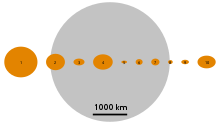
Discovery
On the night of 5 April 1779,
In 1801, the astronomer
A few months later, Olbers was again attempting to locate Ceres when he noticed another moving object in the vicinity. This was the asteroid Pallas, coincidentally passing near Ceres at the time. The discovery of this object created interest in the astronomy community. Before this point it had been speculated by astronomers that there should be a planet in the gap between Mars and Jupiter. Now, unexpectedly, a second such body had been found.[25] When Pallas was discovered, some estimates of its size were as high as 3,380 km in diameter.[26] Even as recently as 1979, Pallas was estimated to be 673 km in diameter, 26% greater than the currently accepted value.[27]
The orbit of Pallas was determined by Gauss, who found the period of 4.6 years was similar to the period for Ceres. Pallas has a relatively high orbital
Later observations
In 1917, the Japanese astronomer Kiyotsugu Hirayama began to study asteroid motions. By plotting the mean orbital motion, inclination, and eccentricity of a set of asteroids, he discovered several distinct groupings. In a later paper he reported a group of three asteroids associated with Pallas, which became named the Pallas family, after the largest member of the group.[28] Since 1994 more than 10 members of this family have been identified, with semi-major axes between 2.50 and 2.82 AU and inclinations of 33–38°.[29] The validity of the family was confirmed in 2002 by a comparison of their spectra.[30]
Pallas has been observed occulting stars several times, including the best-observed of all asteroid occultation events, by 140 observers on 29 May 1983. These measurements resulted in the first accurate calculation of its diameter.[31][32] After an occultation on 29 May 1979, the discovery of a possible tiny satellite with a diameter of about 1 km was reported, which was never confirmed.
Radio signals from spacecraft in orbit around Mars and/or on its surface have been used to estimate the mass of Pallas from the tiny perturbations induced by it onto the motion of Mars.[33]
The Dawn team was granted viewing time on the Hubble Space Telescope in September 2007 for a once-in-twenty-year opportunity to view Pallas at closest approach, to obtain comparative data for Ceres and Vesta.[34][35]

Name and symbol

Pallas is an epithet of the Greek goddess
The adjectival form of the name is Palladian.
The old
Orbit and rotation
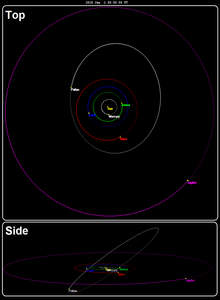
Pallas has unusual dynamic parameters for such a large body. Its
Near resonances
Pallas is in a near-1:1 orbital resonance with Ceres, which is probably coincidental.[44] Pallas also has a near-18:7 resonance (91,000-year period) and an approximate 5:2 resonance (83-year period) with Jupiter.[45]
-
Animation of the Palladian orbit in the inner Solar System
- Pallas
- Ceres
- Jupiter
- Mars
- Earth
- Sun
-
An animation of Pallas's near-18:7 resonance with Jupiter. The orbit of Pallas is green when above the ecliptic and red when below. It only marches clockwise: it never halts or reverses course (i.e. no libration). The motion of Pallas is shown in a reference frame that rotates about the Sun (the center dot) with a period equal to Jupiter's orbital period. Accordingly, Jupiter's orbit appears almost stationary as the pink ellipse at top left. Mars's motion is orange, and the Earth–Moon system is blue and white.
Transits of planets from Pallas
From Pallas, the planets Mercury, Venus, Mars, and Earth can occasionally appear to transit, or pass in front of, the Sun. Earth last did so in 1968 and 1998, and will next transit in 2224. Mercury did in October 2009. The last and next by Venus are in 1677 and 2123, and for Mars they are in 1597 and 2759.[46]
Physical characteristics

Graphs are unavailable due to technical issues. There is more info on
1 Ceres . The unit of mass is ×1018 kg.Both Vesta and Pallas have assumed the title of second-largest asteroid from time to time.[47] At 513±3 km in diameter,[9] Pallas is slightly smaller than Vesta (525.4±0.2 km[48]). The mass of Pallas is 79%±1% that of Vesta, 22% that of Ceres, and a quarter of one percent that of the Moon. Pallas is farther from Earth and has a much lower albedo than Vesta, and hence is dimmer as seen from Earth. Indeed, the much smaller asteroid 7 Iris marginally exceeds Pallas in mean opposition magnitude.[49] Pallas's mean opposition magnitude is +8.0, which is well within the range of 10×50 binoculars, but, unlike Ceres and Vesta, it will require more-powerful optical aid to view at small elongations, when its magnitude can drop as low as +10.6. During rare perihelic oppositions, Pallas can reach a magnitude of +6.4, right on the edge of naked-eye visibility.[17] During late February 2014 Pallas shone with magnitude 6.96.[h] Pallas is a B-type asteroid.[10] Based on spectroscopic observations, the primary component of the material on Pallas's surface is a silicate containing little iron and water. Minerals of this type include olivine and pyroxene, which are found in CM chondrules.[50] The surface composition of Pallas is very similar to the Renazzo carbonaceous chondrite (CR) meteorites, which are even lower in hydrous minerals than the CM type.[51] The Renazzo meteorite was discovered in Italy in 1824 and is one of the most primitive meteorites known.[52][i] Pallas's visible and near-infrared spectrum is almost flat, being slightly brighter in towards the blue. There is only one clear absorption band in the 3-micron part, which suggests an anhydrous component mixed with hydrated CM-like silicates.[10] Pallas's surface is most likely composed of a silicate material; its spectrum and calculated density (2.89±0.08 g/cm3) correspond to CM chondrite meteorites (2.90±0.08 g/cm3), suggesting a mineral composition similar to that of Ceres, but significantly less hydrated. To within observational limits, Pallas appears to be saturated with craters. Its high inclination and eccentricity means that average impacts are much more energetic than on Vesta or Ceres (with on average twice their velocity), meaning that smaller (and thus more common) impactors can create equivalently sized craters. Indeed, Pallas appears to have many more large craters than either Vesta or Ceres, with craters larger than 40 km covering at least 9% of its surface.[9] Pallas's shape departs significantly from the dimensions of an equilibrium body at its current rotational period, indicating that it is not a dwarf planet. Pallas probably has a quite homogeneous interior. The close match between Pallas and CM chondrites suggests that they formed in the same era and that the interior of Pallas never reached the temperature (≈820 K) needed to dehydrate silicates, which would be necessary to differentiate a dry silicate core beneath a hydrated mantle. Thus Pallas should be rather homogeneous in composition, though some upward flow of water could have occurred since. Such a migration of water to the surface would have left salt deposits, potentially explaining Pallas's relatively high albedo. Indeed, one bright spot is reminiscent of those found on Ceres. Although other explanations for the bright spot are possible (e.g. a recent ejecta blanket), if the near-Earth asteroid Geminid meteor shower caused by Phaethon.[9]
Surface featuresBesides one bright spot in the southern hemisphere, the only surface features identified on Pallas are craters. As of 2020, 36 craters have been identified, 34 of which are larger than 40 km in diameter. Provisional names have been provided for some of them. The craters are named after ancient weapons.[9]
SatellitesA small moon about 1 kilometer in diameter was suggested based on occultation data from 29 May 1978. In 1980, speckle interferometry suggested a much larger satellite, whose existence was later refuted a few years later with occultation data.[53]
ExplorationPallas itself has never been visited by spacecraft. Proposals have been made in the past though none have come to fruition. A flyby of the Dawn probe's visits to 4 Vesta and 1 Ceres was discussed but was not possible due to the high orbital inclination of Pallas.[54][55] The proposed Athena SmallSat mission would have been launched in 2022 as a secondary payload of the Psyche mission and travel on separate trajectory to a flyby encounter with 2 Pallas,[56][57] though was not funded due to being outcompeted by other mission concepts such as the Transorbital Trailblazer Lunar Orbiter. The authors of the proposal cited Pallas as the "largest unexplored" protoplanet with the main belt.[58][59] Gallery
See alsoNotes
References
External linksLook up Pallas in Wiktionary, the free dictionary. Wikimedia Commons has media related to (2) Pallas.
|

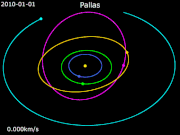
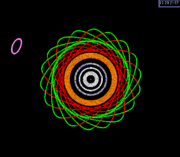
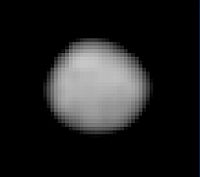


![Objects considered for dwarf planet status under the IAU's 2006 draft proposal on the definition of a planet.[60] Pallas is second from the right, bottom row.](http://upload.wikimedia.org/wikipedia/commons/thumb/7/72/Iau_dozen.jpg/200px-Iau_dozen.jpg)
